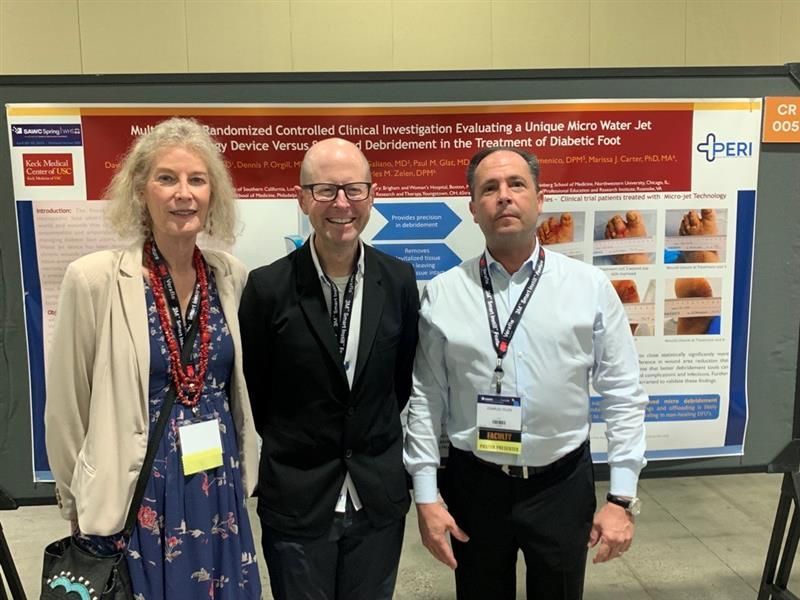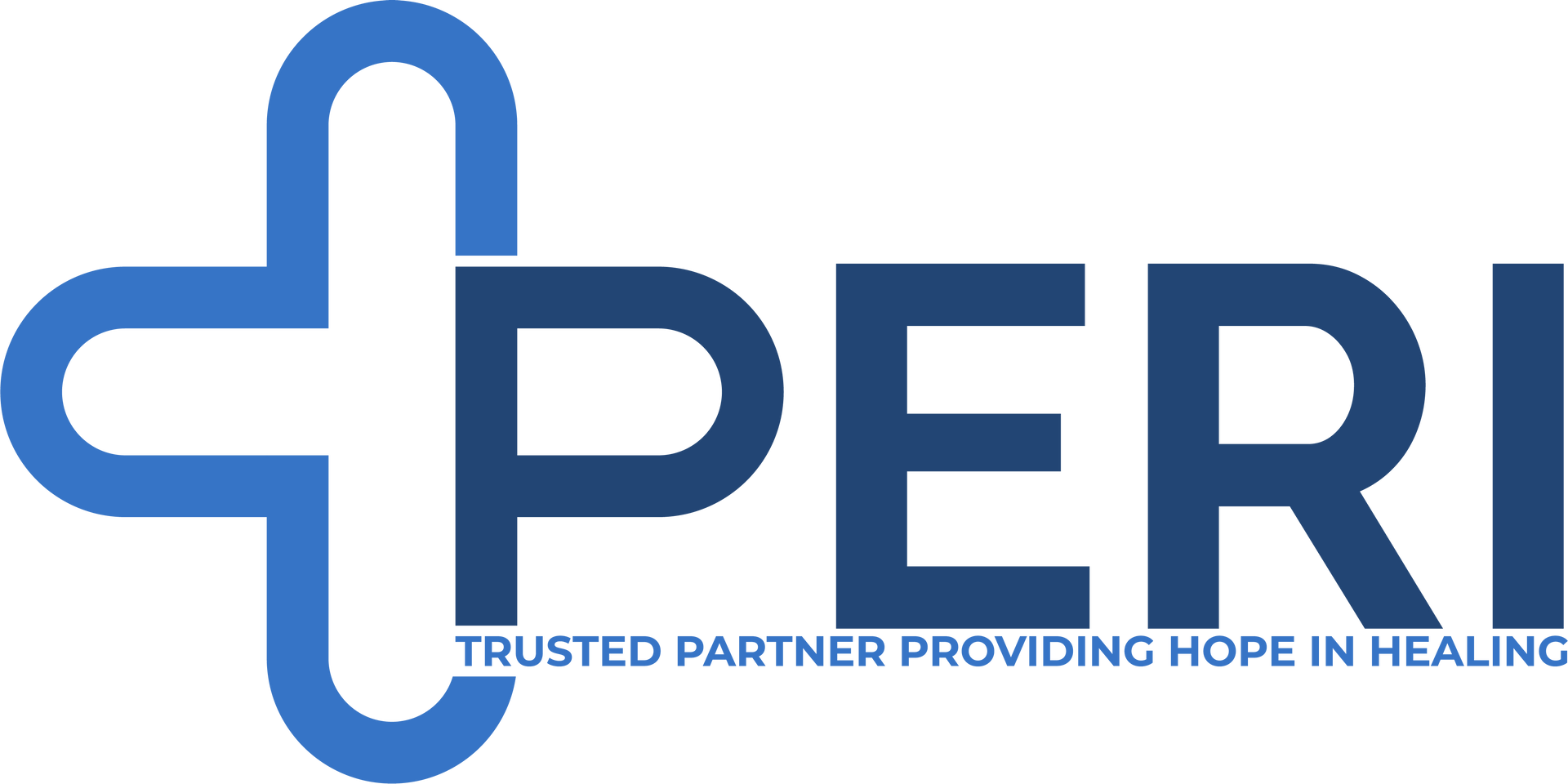PERI NEWS

01 May, 2023
Cincinnati, OH, May, 1st 2023 - PERI, a leading contract research organization, is proud to announce that its President, Charles Zelen, DPM, along with David Armstrong, DPM, MD, Ph.D., Dr. Dennis P. Orgill, MD, Ph.D., Robert D. Galliano, MD, Paul M. Glat, MD, and Marissa J. Carter, Ph.D., MA, has won 2nd place in podium presentation for SAWC's 2023 highest-scoring abstract for their research with Medaxis. The research, titled "Multicenter, Randomized Controlled Clinical Investigation Evaluating a Unique Micro Water Jet Technology Device Versus Standard Debridement in the Treatment of Diabetic Foot," is a breakthrough in treating diabetic foot. The study evaluated a unique micro water jet technology device versus standard debridement in treating diabetic foot. The results showed that the micro water jet technology device was more effective than standard debridement in promoting faster healing in patients with diabetic foot. "We are thrilled to be recognized for our research in diabetic foot ulcer treatment," said Charles Zelen, President of PERI. "This study is a testament to our commitment to innovation and finding new ways to improve patient outcomes." The research was conducted in collaboration with Medaxis and involved a multicenter, randomized, controlled clinical investigation with interim results in 50 participants. The study was conducted over 16 weeks and assessed the primary endpoint of complete wound closure at 16 weeks. The secondary endpoints were percent area reductions and the proportion of wounds with at least one infection. The results showed 72% of the Micro Water jet treated DFUs healed compared with 40% treated with standard sharp debridement. In addition, the percent area reduction was 86.5% for the wounds treated with the Micro Water jet versus 35.1% with standard of care, sharp wound debridement. The safety analysis regarding wound-related adverse events (AE) and serious adverse events (SAE) showed 1 AE and 1 SAE occurring in the Micro Water jet group versus 9 AEs and 4 SAEs in the standard-of-care sharp debridement group. The proportion of wounds having at least one infection or cellulitis episode by 16 weeks was 4% in the Micro Water jet cohort versus 24% in the standard of care, wound debridement group. “It is heartening to see more and more data supporting good quality wound preparation. The healing rates we are seeing so far are outstanding. We look forward to further data confirming or refuting these promising findings,” says Professor David G. Armstrong from the Surgery Department at the Keck University School of Medicine. The award-winning research was presented at the SAWC Spring annual meeting, which was held in Prince George's County, MD, on April 28th, 2023. The study is expected to attract significant attention from researchers and medical professionals in the wound healing industry. References 2023. Multicenter, Randomized Controlled Clinical Investigation Evaluating a Unique Micro Water Jet Technology Device Versus Standard Debridement in the Treatment of Diabetic Foot. [Poster] Symposium on Advanced Wound Care (SAWC) Spring, April 28th, 2033, Prince George's County, MD. About PERI PERI is a contract research organization conducting pre- and post-market clinical trials. The company has extensive experience working with pharmaceutical, biotechnology, medical device companies, and academic institutions. With a team of experienced professionals, PERI is committed to delivering high-quality research services that meet the needs of its clients. For more information, please visit periedu.com. Contact: Kelsea Filter Marketing Manager (513) 230-2645 kfilter@periedu.com
By Professional Education & Research Institute, LLC
•
26 Sep, 2022
The Professional Education and Research Institute, LLC (PERI), a Clinical Research Organization that specializes in Phase 1 through Phase IV clinical trials for biologics, drugs, and devices, is thankful for the opportunity to work with Compedica Limited: United Kingdom (Compedica), a medical device company, on the OptiPulse™ active therapy system (Compedica Limited; United Kingdom) clinical trial recently published in the International Wound Journal. (https://onlinelibrary.wiley.com/doi/full/10.1111/iwj.13932) In this single-arm prospective feasibility study, trial subjects with Wagner grade 1 non-healing diabetic foot ulcers were treated with the OptiPulse™ active therapy system (Compedica Limited; United Kingdom) and 80% healed within 12 weeks. As a result, wound healing accelerated, and pain improved for trial subjects.1 Dan Blackman, Chief Operating Officer of Compedica states; “These results are very exciting and support our belief that mobile intermittent plantar compression combined with offloading and patient monitoring can have significant benefits to healing DFUs. We are pleased to continue our work with PERI to build on these promising initial findings.” OptiPulse™ active therapy system (Compedica Limited; United Kingdom) is a device designed to offload the wound, enhance circulation, and monitor patient compliance. The study, “A single arm prospective feasibility study evaluating wound closure with a unique wearable device that provides intermittent plantar compression and offloading in the treatment of non-healing diabetic foot ulcers,” evaluated the safety and efficacy of the OptiPulse™ active therapy system (Compedica Limited; United Kingdom) for 10 patients with non-healing DFUs for up to 12 weeks. The primary endpoint was complete wound closure at 12 weeks, and secondary endpoints included healing time, percent area reduction, and changes in pain using the visual analog pain scale. Eight out of ten wounds healed within 12 weeks (80%), and the mean healing time was 41 days(95% CI:24.3–58.3). The percent area reduction was 75(SD:53.9). The baseline visual analog pain scale was 4.5(2.9) as compared with 3.3(3.4) at the end of the study. No device-related or serious adverse events were reported. 1 In conclusion, this unique intermediate plantar compression and offloading device may be considered an alternative for the safe and effective treatment of non-healing diabetic foot ulcers. Sources: 1. Armstrong DG, Orgill DP, Glat PM, et al. A single arm prospective feasibility study evaluating wound closure with a unique wearable device that provides intermittent plantar compression and offloading in the treatment of non-healing diabetic foot ulcers. Int Wound J. 2022;1‐8. doi:10.1111/iwj.13932
06 Jul, 2022
The Professional Education and Research Institute (PERI), a Clinical Research Organization that specializes in Phase I through Phase IV clinical trials for biologics, drugs, and devices, is grateful for the opportunity to work with Misonix Inc. now Bioventus, a global biotechnology company on the Theraskin trial recently published in the International Wound Journal ( https://onlinelibrary.wiley.com/doi/10.1111/iwj.13759 ). Briefly, in this Level one clinical evidence trial subjects with non-healing ulcers treated with TheraSkin in addition to Standard of Care (SOC) wound treatment had significantly improved healing versus SOC treatment alone. Alan Staley the former president of Misonix, states; “this landmark trial compliments our already existing science and publications on this unique living cell graft.” TheraSkin is a split thickness allograft (BSA) that, in combination with SOC, has the potential to improve wound healing in Diabetic Foot Ulcers drastically. The study " A Multi-centre prospective randomized controlled clinical trial to evaluate a bioactive split thickness skin allograft vs standard of care in the treatment of diabetic foot ulcers" compared the response of 100 subjects with non-healing DFUs. Fifty subjects were treated with a cryopreserved bioactive split thickness skin allograft (BSA) (TheraSkin; Bioventus) alone with appropriate standard wound treatment compared with 50 subjects treated with standard of care alone (collagen alginate dressing) for 12 weeks The primary endpoint was the proportion of full-thickness wounds healed at 12 weeks, with secondary endpoint that include differences in percent area reduction (PAR) at 12 weeks,. The results illustrated in the intent-to-treat analysis at 12 weeks showed that 76% (38/50) of the BSA-treated DFUs healed compared with 36% (18/50) treated with SOC alone (adjusted P = .00056). In addition, the mean PAR at 12 weeks was 77.8% in the BSA group compared with 49.6% in the SOC group (adjusted P = .0019). In conclusion, adding BSA to SOC appeared to significantly improve wound healing with a lower incidence of treatment-related adverse events compared with SOC alone. Sources: Armstrong DG, Galiano RD, Orgill DP, et al. Multi-centre prospective randomised controlled clinical trial to evaluate a bioactive split thickness skin allograft vs standard of care in the treatment of diabetic foot ulcers. Int Wound J. 2022;19(4):932-944. doi:10.1111/iwj.13759
Want more information?

© 2024
Professional Education and Research Institute, LLC
Cincinnati -- Corporate Headquarters
9825 Kenwood Road, Suite 100
Blue Ash, Ohio 45242
Latest news
